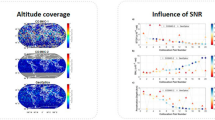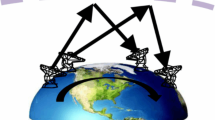Abstract
The planetary radio occultation technique is one of the earliest suggested and achieved methods to detect the planetary atmosphere, and has been conducted by almost every deep space planetary probe. The principles, modules, inversion results and primary analysis of the SHAO Planetary Occultation observation Processing system (SPOPs) are presented in this paper. Utilizing open-loop and closed-loop Doppler residual data of the Mars Express radio occultation experiment provided by ESA PSA and NASA PDS, the temperature, pressure, molecular number density profiles of Martian atmosphere and electron density profiles of the ionosphere are successfully retrieved, and the results are validated by the released radio science level 04 products of the ESA MaRS group. This system can also process the atmosphere radio occultation observations of other planets and theirs natural satellites. The implementation of the planetary radio occultation technique is of significance to China’s YH-1 Mars exploration project, as well as for future planetary exploration missions from China.
Similar content being viewed by others
References
Asmar S W, Renzetti N A. The Deep Space Network as an Instrument for Radio Science Research. Pasadena: JPL Publication, 1993. 80–93
Kliore A J, Hamilton T W, Cain D L. Determination of Some Physical Properties of the Atmosphere of Mars From Changes in the Doppler Signal of a Spacecraft on an Earth Occultation Trajectory. Pasadena: JPL Publication, 1964. 32–674
Kliore A J, Cain D L, Levy G S, et al. Occultation experiment: results of the first direct measurement of Mars’ atmosphere and ionosphere. Science, 1965, 149: 1243–1248
Fjeldbo G, Eshleman V R. The atmosphere of Mars analyzed by integral inversion of the Mariner IV occultation data. Planet. Space Sci, 1968, 16: 1035–1059
Fjeldbo G, Kliore A J, Eshleman V R. The neutral atmosphere of Venus as studied with the Mariner V radio occultation experiments. Astron J, 1971, 76: 123–140
Kliore A J, Levy G S, Cain D L, et al. Atmosphere and ionosphere of Venus from the Mariner V S-band radio occultation measurement. Science, 1967, 158: 1683–1689
Kliore A J, Fjeldbo G, Seidel B L, et al. Mariners 6 and 7: Radio occultation measurements of the atmosphere of Mars. Science, 1969, 166: 1393–1397
Kliore A J, Cain D L, Fjeldbo G, et al. The atmosphere of Mars from Mariner 9 radio occultation measurements. Icarus, 1972, 17: 484–516
Tyler G L, Almino G B, Hinson D P, et al. Radio science investigations with Mars observer. J Geophys Res, 1992, 97: 7759–7779
Cahoy K L, Hinson D P, Tyler G L. Radio science measurements of atmospheric refractivity with Mars global surveyor. J Geophys Res, 2006, 111: E05003, doi:10.1029/2005JE002634
Hinson D P, Wilson R J. Temperature inversions, thermal tides, and water ice clouds in the Martian tropics. J Geophys Res, 2004, 109: E01002, doi:10.1029/2003JE002129
Pätzold M, Tellmann S, Haeusler B, et al. A Sporadic third layer in the ionosphere of Mars. Science, 2005, 310: 837–839
Howard H T, Tyler G L, Esposito P B, et al. Mercury: Results on mass, radius, ionosphere from Mariner 10 dual-frequency radio signals. Science, 1974a, 185:179–180
Fjeldbo G, Kliore A, Sweetnam D, et al. The occultation of Mariner 10 by Mercury. Icarus, 1976, 29: 439–444
Howard H T, Tyler G L, Fjeldbo G, et al. Venus: Mass, gravity field, atmosphere and ionosphere as measured by the Mariner 10 dual-frequency radio system. Science, 1974b, 183: 1297–1301
Kliore A J, Fjeldbo G, Seidel B L, et al. The atmosphere of Jupiter from Pioneer 11 s-band occultation experiment: Preliminary results. Science, 1975, 188: 474–476
Kliore A J, Woo R, Armstrong J W, et al. The polar ionosphere of venus near the terminator from early pioneer venus orbiter radio occultation. Science, 1979a, 203: 765–768
Kliore A J, Patel I R, Nagy A F, et al. Initial observations of the nightside ionosphere of venus form pioneer venus orbiter radio occultations. Science, 1979b, 205: 99–102
Lindal G F. The atmosphere of Neptune: An analysis of radio occultation data acquired with Voyager 2. Astron J, 1992, 103: 967–982
Tyler G L, Sweetnam D N, Anderson J D, et al. Voyager radio science observations of Neptune and Triton. Science, 1989, 246: 1466–1473
Hinson D P, Twicken J D, Karayel E T. Jupiter’s ionosphere: New results from the first Voyager 2 radio occultation measurements. J Geophys Res, 1998, 103: 9505–9520
Tyler G L. Radio propagation experiments in the outer solar system with Voyager. Proc IEEE, 1987, 75: 1404–1431
Hinson D P, Flasar F M, Kliore A J, et al. Jupiter’s ionosphere: Results from the first Galileo radio occultation experiment. Geophys Res Lett, 1997, 24: 2107–2110
Bird M K, Asmar S W, Edenhofer P, et al. The structure of Jupiter’s Io plasma torus inferred from Ulysses radio occultation observations. Planet Space Sci, 1993, 41: 999–1010
Bougher S W, Engel S, Hinson D P, et al. MGS Radio Science electron density profiles: Interannual variability and implications. J Geophys Res, 2004, 109: E03010, doi:10.1029/2003JE002154
Hinson D P, Paetzold M, Wilson R J, et al. Radio occultation measurements of transient eddies in the northern hemisphere of Mars. J Geophys Res, 2006, 111: E05002, doi: 10.1029/2005JE002612
Hinson D P. Radio occultation measurements and MGCM simulations of Kelvin waves on Mars. ICARUS, 2008, 193: 125–138
Krymskii A M, Breus T K, Ness N F, et al. Effect of crustal magnetic fields on the near terminator ionosphere at Mars: Comparison of in situ magnetic field measurements with the data of radio science experiments on board Mars global surveyor. J Geophys Res, 2003, 108: 1431–1443, doi: 10.1029/2002JA009662
Fjeldbo G, Eshleman V R, Garriott O K, et al. The two-frequency bistatic radio-occulation method for the study of planetary ionospheres. J Geophys Res, 1965, 70: 3701–3709
Han T T, Mao X F, Zahng S J, et al. The time and coordinate systems of Earth-based Mars atmosphere occultation (in chinese). Ann Shanghai Astron Observatory, 2009, 30: 22–32
Zhang S J, Ping J S, Hong Z J, et al. Detection of Martian atmosphere and ionosphere using spacecraft-earth radio occultation technique (in chinese). Physics, 2009, 38: 467–473
Allen C W. Astrophysical Quantities. 4th ed. London: The Athlone Press, 1999. 13–22
Author information
Authors and Affiliations
Corresponding author
Rights and permissions
About this article
Cite this article
Zhang, S., Ping, J., Han, T. et al. Implementation of the Earth-based planetary radio occultation inversion technique. Sci. China Phys. Mech. Astron. 54, 1359–1366 (2011). https://doi.org/10.1007/s11433-011-4247-7
Received:
Accepted:
Published:
Issue Date:
DOI: https://doi.org/10.1007/s11433-011-4247-7




